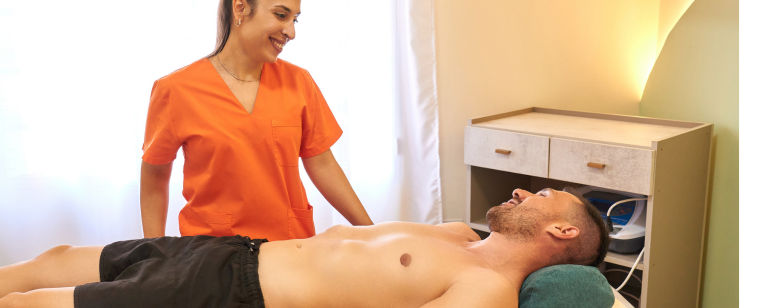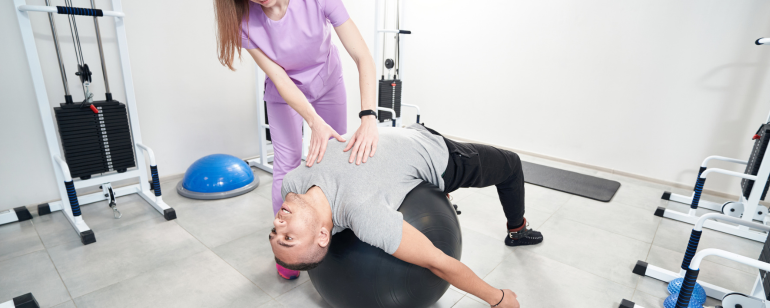Pain between the shoulder blades or in the middle of the back is one of the most common complaints in the practice. It often develops gradually – at first the back feels “tired”, later pulling or stabbing pain occurs, sometimes radiating into the neck or chest.
Unlike acute injuries, the causes are usually functional, i.e. due to posture, movement or muscular imbalances.
Typical causes of pain in the middle back and between the shoulder blades
1. incorrect posture and static load
Sitting for long periods, having a hunched back or leaning your head forward (e.g. when using a computer or smartphone) lead to permanent stretching and overloading of the postural muscles in the mid-back.
The chest muscles shorten, the shoulders pull forward and the muscles between the shoulder blades lose their holding function.
2. muscle tension and trigger points
Small, pain-sensitive points (trigger points) in the muscles and fascia can cause pain that radiates into the arm or neck. Frequently affected are the trapezius muscle, the rhomboids (the rhomboids are two diamond-shaped muscles in the upper back that connect the shoulder blade to the spine) and the levator scapulae (a muscle in the neck and upper back that lifts the shoulder blade and helps to raise the arm or shoulders).
3. limited mobility of the thoracic spine
A blocked or immobile thoracic spine leads to movements from the neck and lumbar spine being compensated for. In the long term, this leads to incorrect strain and pain in the shoulder blade area.
4. stress and shallow breathing
Under stress, many people breathe shallowly and raise their shoulders slightly with every breath. This causes the auxiliary breathing muscles in the upper back to tense up – especially the scalenius and upper trapezius muscles.
5. lack of core strength
If the abdominal and back muscles are too weak, there is a lack of stability in the trunk. The mid-back takes on compensatory holding work for which it is not designed.

Physiotherapeutic treatment
The treatment of pain in the middle back and between the shoulder blades begins with a thorough functional analysis. This involves checking posture, mobility, muscle tension and breathing mechanics. The aim is to understand the cause of the pain – not just to treat the symptom.
Manual techniques
Targeted gripping techniques are used to release blocked or immobile segments of the thoracic spine. This mobilization improves circulation, relieves nerve roots and normalizes the interaction between vertebrae, ribs and muscles.
The joints between the shoulder blade and rib cage are also worked on manually, as there are often movement restrictions there that cause pressure or tension in the entire upper back.
Posture and movement training
Patients learn to recognize poor posture and actively correct it. In everyday life, this means consciously lowering the shoulders backwards, raising the sternum slightly and planning regular breaks for movement.
Ergonomic tips for working at a computer or driving are also part of the physiotherapeutic education.
Breathing and relaxation techniques
A key part of the therapy is restoring natural, deep breathing. Many sufferers breathe shallowly and raise their shoulders slightly with each breath. Exercises to activate the diaphragm and mobilize the ribcage improve the oxygen supply and noticeably reduce tension in the upper back.
Strengthening the postural muscles
Patients learn to recognize poor posture and actively correct it. In everyday life, this means consciously lowering the shoulders backwards, raising the sternum slightly and planning regular breaks for movement.
Ergonomic tips for working at a computer or driving are also part of the physiotherapeutic education.
Exercises for pain between the shoulder blades
The following exercises are easy to perform and can be done daily. They promote mobility, circulation and muscle balance.

1. mobilize the thoracic spine
Starting position: Sit on a chair, hands clasped behind your neck.
Movement: Slowly lean your upper body backwards as you inhale and lean forward again slightly as you exhale.
Effect: Mobilizes the thoracic spine and improves posture.
2. activate shoulder blades
Starting position: Stand or sit upright, arms hanging loosely.
Movement: Consciously pull the shoulder blades together and move them slightly downwards – without tension in the neck.
Hold: 5 seconds, 10 repetitions.
Effect: Activates the rhomboids and lower trapezius muscle, stabilizes the shoulder blade.
3. stretching the chest muscles
Starting position: Standing in a doorway, place your forearms on the frame.
Movement: Lean forward slightly until you feel a stretch in your chest.
Hold: 20-30 seconds, 2-3 repetitions.
Effect: Releases tightness and improves posture.
4. strengthening with resistance band
Starting position: Fix the Theraband at chest height, hold the ends with both hands.
Movement: Pull arms back, bring shoulder blades together, release slowly.
Repetitions: 12-15 times.
Effect: Strengthens the back muscles, improves posture control.
Conclusion
Pain between the shoulder blades or in the mid-back is usually the result of muscular imbalances and restricted mobility – not necessarily structural damage.
Targeted physiotherapy treatment and regular training can effectively alleviate discomfort.
If you improve your posture, strengthen your core muscles and breathe consciously, you can avoid back pain permanently and return to a stable, relaxed body.
